“Cooler than Cool Roofs: How Heat Doesn’t Move Through a Green Roof”
“Cooler than Cool Roofs: How Heat Doesn’t Move Through a Green Roof” is the 7-part Green Roof Energy Series explaining the key aspects of green roof heat transfer issues and the best ways to take advantage of a green roof’s energy benefits by Greenroofs.com collaborator Chris Wark.
Green Roof Energy Series Part 2: Evapotranspiration
By Chris Wark, Energy Editor – Originally posted June 29, 2010
Anyone delving into the world of green roofs will hear the word “evapotranspiration” sooner or later. Sure, it’s fun to say, what with all those syllables (as many as seven), but what does this word mean? Evapotranspiration can be thought of as vegetation’s version of sweating. In short, it is the transport of water to the stomata, or “pores”, of a leaf where it evaporates, plus the evaporation of moisture sitting elsewhere on the foliage and soil, all of which help cool the plant.
Last month, I referred to evaporation as one way in which heat energy is removed from a green roof (Part 1: The Essentials – Heat Transfer by Layer) and evapotranspiration is the more specific term for the way evaporation removes that heat. For those who want to spend a little more time diving into the details of this topic, some websites with excellent primers on evapotranspiration are listed at the end of this article (Ref. 1 through 4).
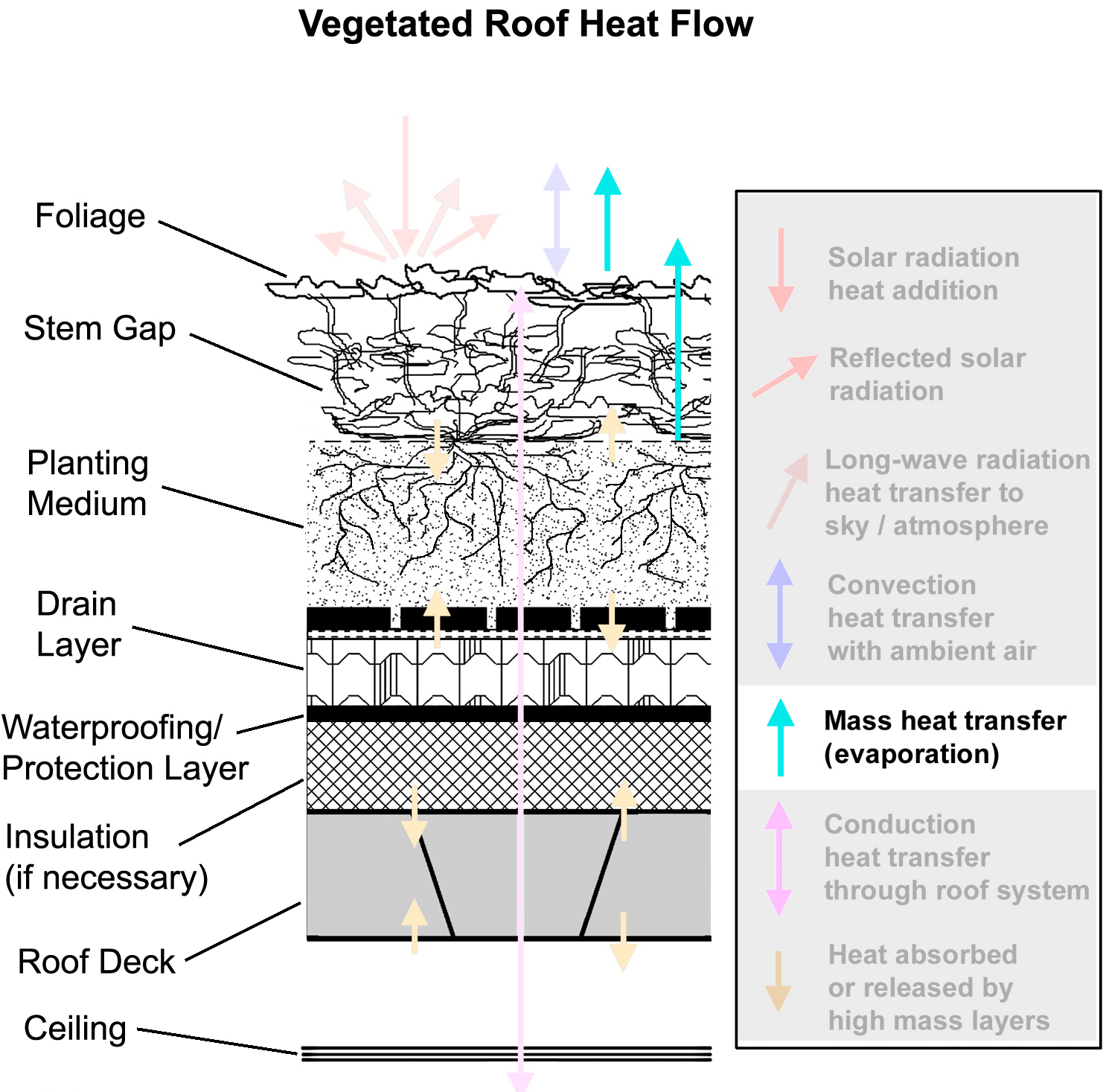
Copyright 2010 Christopher Wark
Another important question: why am I dedicating an entire month’s worth of thought and typing to a single, specialized form of heat transfer? The answer is purely anecdotal. When the subject of energy and green roofs comes up, nearly everyone familiar with the topic will tell me that green roofs stay cool because of evapotranspiration.
Evapotranspiration
Why, even when discussing it with professional engineers doing building energy modeling, they assume that most of the cooling ability of a green roof is through evapotranspiration.
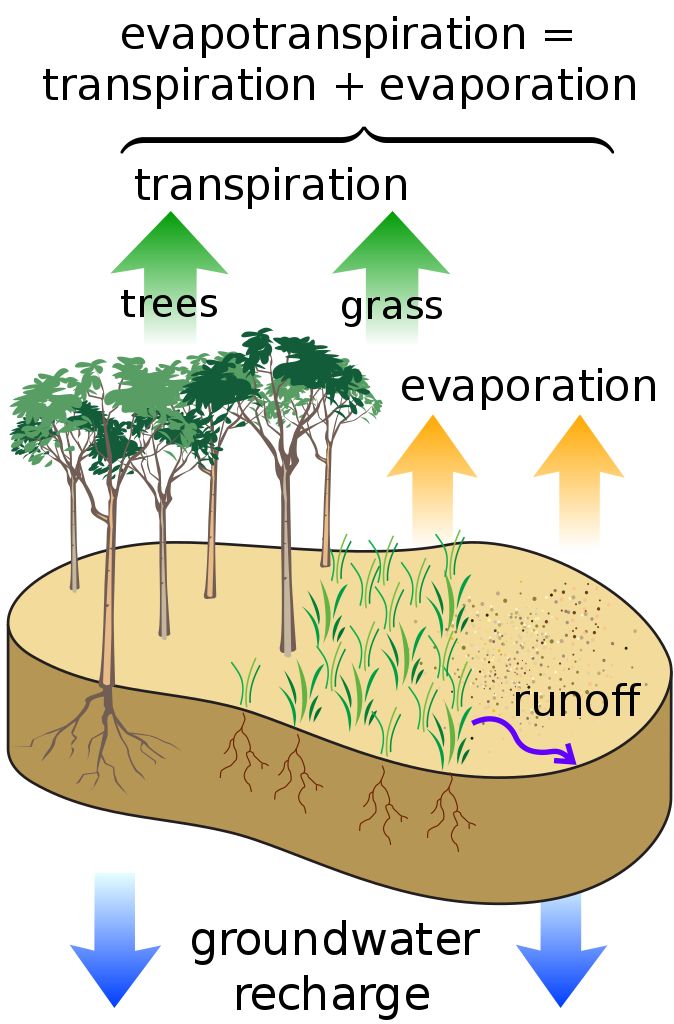
ET = E+T. M. W. Toews [CC BY 4.0 (https://creativecommons.org/licenses/by/4.0)]
Some of them completely ignore the four other ways in which the vegetation deals with excess heat energy, which results in big analysis errors. We need to put the importance of evapotranspiration in perspective and should start by trying to understand what it is and where the idea of its significance comes from.
Evapotranspiration is actually a combination of two words: evaporation and transpiration. Let’s look at transpiration first. It is the process by which water is pumped from the soil (or planting medium) through the roots, up through the stems and out through the leaves by means of the force of evaporation at the tiny stomatal openings.
The physics of how the force of evaporation at a stoma is strong enough to suck water up through the roots is pretty impressive and not easy to understand. As for evaporation, it is exactly what it sounds like – the actual evaporation of water from the surfaces of the leaves, stems, and soil.
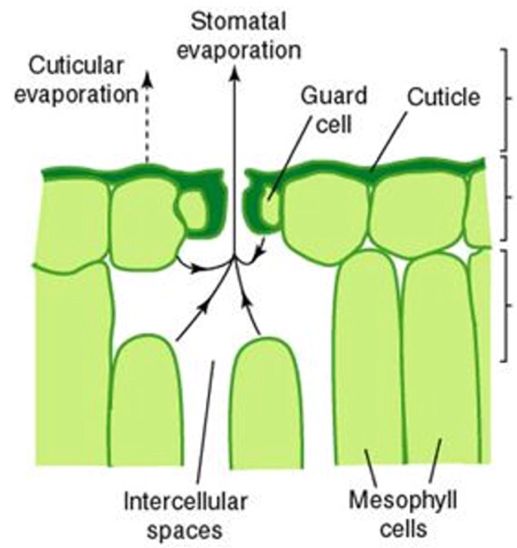
Figure 3: John A. Dutton e-Education Institute, Pennsylvania State University
In figuring out how much evaporation contributes to the cooling of a roof, we need to know the amount of heat carried away from the stoma and all of those other surfaces. Calculating evaporation rates in such a complex environment is, well, complex; however, we can get a pretty reasonable number based on a fundamental physical law: Conservation of Mass.
Conservation of Mass simply states that the amount of water evaporating from a roof must equal the amount of water put on the roof by rain, irrigation, dew, etc. In fact, many farmers in dry regions rely on established evapotranspiration calculations and data to determine how much irrigation is required to keep their crops alive. For instance, an alfalfa farmer in Kansas can expect to dump about 0.2 inches, or about half a pound per square foot, of water per day on his crop during July to make up for water evaporating away through transpiration(5). Half a pound of liquid water goes in through the roots, half a pound of water vapor comes out through the stoma to carry away the heat (thus the term mass heat transfer). The heat needed to evaporate that half pound of water is the amount of heat removal we are calculating.
Ah, but a sedum-covered extensive green roof in Boston is not the same thing as an alfalfa field in Kansas, now, is it? Although several blatant differences come to mind, our focus on evaporation energy ultimately directs us to the effects of planting media depth.
For one thing, alfalfa roots want to travel down through several feet of topsoil while many sedums are quite content in just a few inches of a planting medium, which is one reason why alfalfa is a poor candidate for green roofs (for those not hip to the details of green roof construction, planting media should never be confused with soil and should never, never, ever, ever be referred to as “dirt.”)
For another thing, the Kansas field can hold, then transpirate, a whole lot more storm water than a shallow green roof.
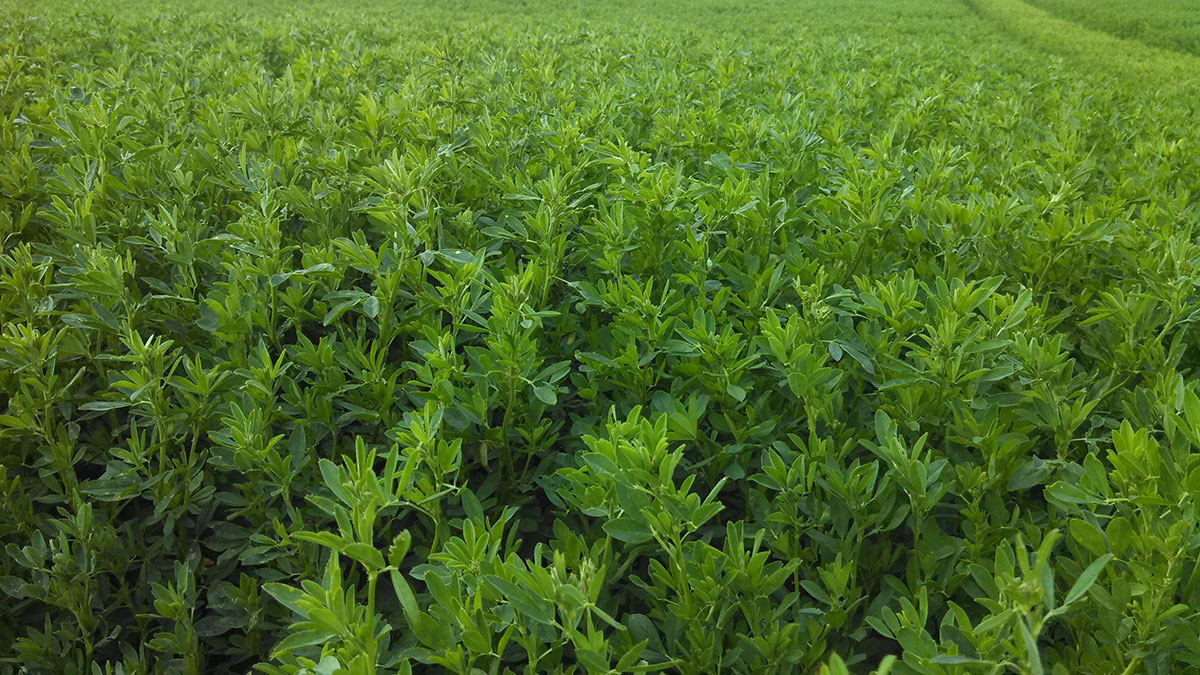
Alfalfa field in Kansas. Image: Kansas Forage and Grassland Council
Before we abandon our alfalfa crop, let’s take a quick look at how much heat is transferred away from that field on a hot summer afternoon through evapotranspiration. Using the Penman-Monteith equations to determine evapotranspiration rates(8) and then energy content equations or tables from one’s thermodynamics textbooks(7,8) or relevant Wikipedia page(9) to calculate the evaporative heat loss, one should come to the conclusion that evapotranspiration only removes about 1/3 of the excess heat coming in from the noontime sun.
So, evapotranspiration is clearly not alfalfa’s primary method of staying cool even though it has deep roots and plenty of water. To keep the crop from cooking before sunset, the other 2/3 of the solar heat must be dealt with by other means such as convection to the air, radiation emission to the sky, and a little bit of conduction back into the ground.
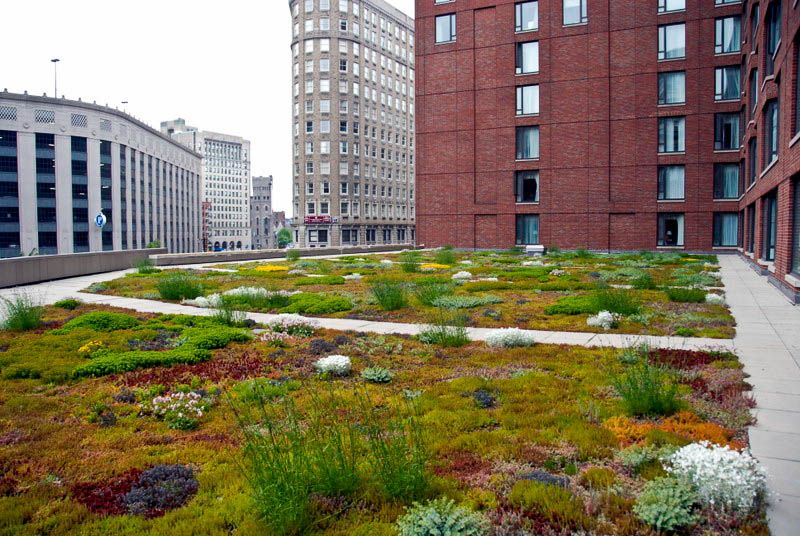
Four Seasons Hotel in Boston. Image: Pinterest via Apex Green Roofs
How does this compare with our sedum covered green roof in Boston? Assuming that the established sedums’ water needs are satisfied by typical rainfall amounts, we can crank through the same equations used for the alfalfa crop to conclude that our non-irrigated green roof uses evapotranspiration to rid the roof of only 10% of the solar heat. Considering that the sun can account for about 95% of the excess heat coming in through a roof, evapotranspiration alone would lower the temperature of a typical extensive green roof by only a few degrees and leave us with a bunch of fried sedum. In reality, all of that solar heat energy does get dissipated through the four other ways described last month, along with evapotranspiration.
But if you are a huge fan of evapotranspiration and insist on utilizing it as your primary source of roof cooling, you can always install the equivalent of a hydroponic garden and essentially turn the roof into one big swamp cooler. Good luck with the water bills.
The moral of this story is that we need to pay more attention to all those other ways of moving heat away from a green roof if we want an accurate picture of how a green roof stays cool, particularly for low-maintenance extensive systems. Do you think we can learn something from desert plants? I think we can. Check in next month when the spotlight is on survival techniques of drought-resistant plants.
Copyright 2010 Christopher Wark
~ Chris Wark
References:
1. www.fao.org/docrep/X0490E/x0490e00.HTM Comprehensive guidelines on crop evapotranspiration from the Food and Agriculture Organization of the United Nations. Includes considerable background information, calculation methods and explanations, and world-wide climate and crop data.
2. www.cimis.water.ca.gov/cimis/infoEtoOverview.jsp Background information for the California Irrigation Management Information System (CIMIS).
3. www.dpi.qld.gov.au/26_9829.htm Good, concise overview of agricultural evapotranspiration calculations from the Australian government. Particularly handy for fans of the metric system.
4. https://courseware.e-education.psu.edu/simsphere/workbook/ch07.html This is a more advanced explanation of the details of stomatal heat transfer. Part of the SimSphere Workbook, courtesy of John A. Dutton e-Education Institute, A unit of the College of Earth and Mineral Sciences, The Pennsylvania State University © 2003
5. www.ksre.ksu.edu/library/ageng2/MF2868.pdf
6. www.fao.org/docrep/X0490E/x0490e06.htm#penman%20monteith%20equation
7. Cengel, Yunus A. and Boles, Michael A. Thermodynamics: An Engineering Approach. McGraw Hill, 1994.
8. Mills, A.F. Basic Heat and Mass Transfer. Irwin, 1995.
Publisher’s Note:
See Chris Wark’s entire 7-part Green Roof Energy Series from 2010-2011 online, and in PDF: “Cooler Than Cool Roofs: How Heat Doesn’t Move Through a Green Roof.“
Christopher G. Wark

Christopher Wark is Principal of Wark Energy Consulting and the founder of Ponix MicroAg LLC, a development-stage company that is creating a line of compact plant enclosures for the CEA market. Chris has over 30 years of multidisciplinary engineering experience providing mechanical, analytical, and electronics support and services to manufacturers, universities and national labs. He holds Bachelor and Master of Science degrees in Mechanical Engineering (with a minor in Materials Science) from Washington State University where his graduate work focused on thermodynamics, fluid dynamics, and combustion.
For the past 19 years, Chris has focused his efforts on the development and promotion of technical solutions in architecture and construction. He has provided energy and environmental quality analysis, CFD modeling, and LEED consulting services for several engineering and building consulting firms in New York and California. In 2002, Chris established SHADE Consulting/Green Roof Innovations (GRI) with his wife Wendy.
With GRI, Chris developed several innovative modular eco-roof systems and in 2010, Chris designed a modular planting system in partnership with Guiyang Chuangjia High-Tech Accelerator Co. LTD in Guiyang, China. In Guiyang, he saw how most of the apartment balconies and rooftops were filled with vegetable gardens. The idea of providing an improved environment for food production in built environments, along with key GRI design concepts, inspired the development of the patented pPod™ miniature greenhouse developed by Ponix MicroAg.
Contact Christopher Wark at: cwark@pponix.com, 917-565-6919.
 Greenroofs.comConnecting the Planet + Living Architecture
Greenroofs.comConnecting the Planet + Living Architecture
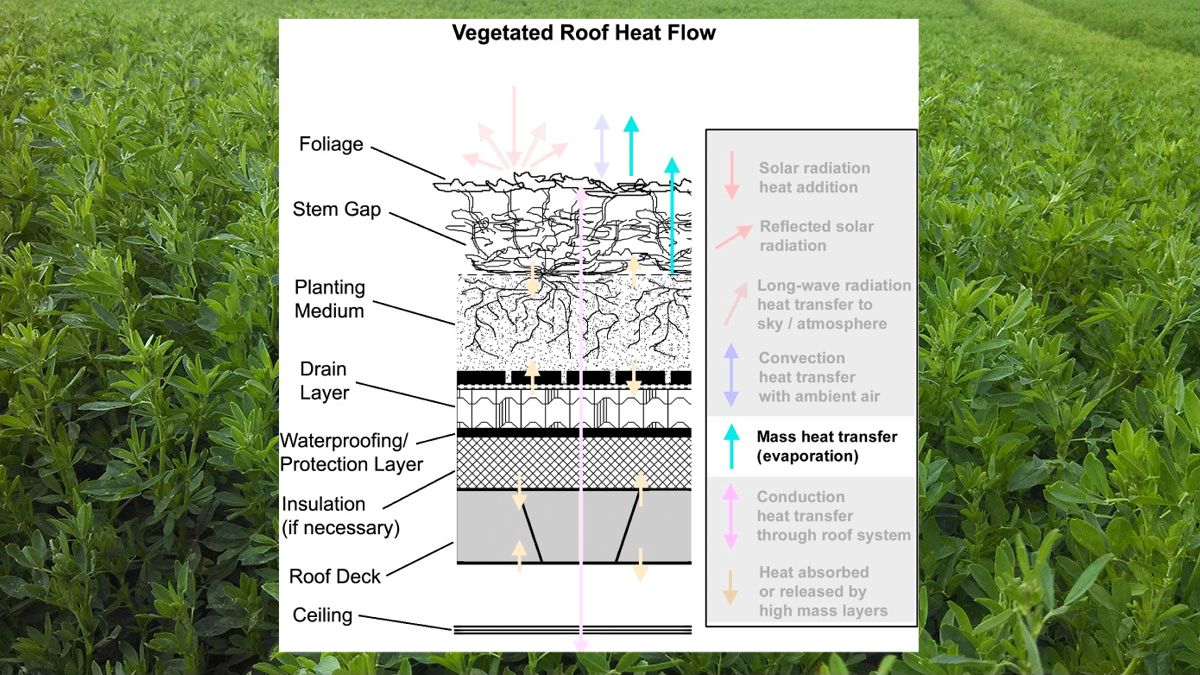





GERARD GANTERT
Wonderfully educational. Looking forward to more information from you Chris.
thank you so much.
G
chrisjackson
Good article with an excellent way of presentation. Keep it up. Thanks for sharing.
https://www.accessdoorsandpanels.com/
monkey
It works really fine. I liked your post. Thanks for sharing!
Derek Campbell
This is a good way to save energy. Thanks for sharing this helpful article.
http://www.oldworldstoneimports.com/
Energy Matters: Q4 2022 – Housing Services Corp
[…] Green roofs help to address the urban heat island effect which makes extreme heat events worse, especially in low-income communities. They do this by helping to reduce ambient temperature through evapotranspiration. […]